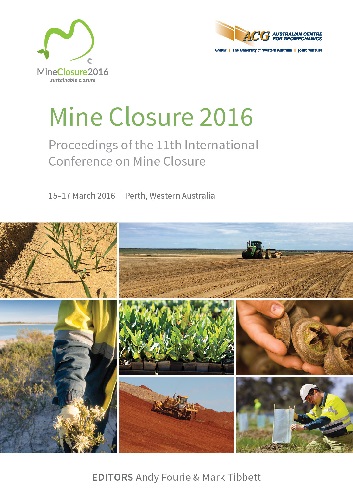Attractive nuisances and wicked solutions

|
Authors: Parshley, JV; MacCallum, CS |
DOI https://doi.org/10.36487/ACG_rep/1608_15_Parshley
Cite As:
Parshley, JV & MacCallum, CS 2016, 'Attractive nuisances and wicked solutions', in AB Fourie & M Tibbett (eds), Mine Closure 2016: Proceedings of the 11th International Conference on Mine Closure, Australian Centre for Geomechanics, Perth, pp. 229-240, https://doi.org/10.36487/ACG_rep/1608_15_Parshley
Abstract:
Mine closure plans generally include the objective of creating sustainable conditions that provide for public health and safety and protect the environment. The mining industry has developed and implemented approaches and technologies to achieve this objective in a variety of contexts. However, some activities will inevitably result in post-mining conditions that become attractive nuisances — conditions that appeal to trespassers who may not understand or appreciate the safety risks to themselves and others. During operations, controls can be implemented and monitored to reduce the risk of exposure to attractive nuisances, but after closure this becomes more difficult. Proactive stakeholder engagement can identify likely post-mining land uses and sustainable livelihoods. However, what happens when these are in conflict with mine closure goals? It is critical to understand the drivers for and context of future land use and livelihood development to mitigate and/or influence the potential impacts of both. In addition, throughout the mine lifecycle (exploration through closure), the operation should support sustainable and responsible development at a community level. Yet, in some instances the social context can severely limit the options for and effectiveness of standard technical closure approaches. In extreme cases, the social context of a project may not lend itself to any solution that achieves the technical and socio economic objectives of closure because of uncontrollable future use of the site. These challenges, along with the consequences of economic disturbance, and population displacement, inequality, and poverty — issues often referred to as a ‘wicked problem’ — are often inadequately addressed. Within the context of closure, this paper compares the complex and multi-dimensional aspects of poverty with the constraints and opportunities posed by mining as a dominant single sector economy. Examples of integrated closure planning, stakeholder engagement, and land use and livelihood development are presented to illustrate successful approaches to avoiding or mitigating attractive nuisances after closure. These successes are contrasted with situations where future land use and livelihood development are less controllable, potentially limiting the effectiveness of industry standard closure practices. In doing so, the authors propose an overarching wicked solution for social closure through livelihood restoration and socially and ecologically sustainable community development practices.
Keywords: stakeholder engagement, land use, attractive nuisance
References:
Alkire, S & Sumner, A 2013, Multidimensional Poverty and the Post-2015 MDGs, OPHI, Oxford.
Australian Government 2015, Leading practice sustainable development programme for the mining industry, mine closure handbook April 2015, Department of Industry and Science,
Bebbington, A 1999, ‘Capitals and capabilities: a framework for analyzing peasant viability, rural livelihoods and poverty’, World development, vol. 27, no. 12, pp. 2021–2044.
Breinard, L & LaFleur, V 2005, Expanding Enterprise, Lifting the Poor, Brookings Blum Roundtable, The Brookings Institute Washington, DC.
Callan, M 2012, What Do We Know about the Private Sector’s Contribution to Development?, Development Policy Centre Discussion Paper 11, Crawford School of Economics and Government ANU, Canberra.
Conklin, J 2006, Dialogue mapping: building shared understanding of wicked problems, Wiley Publishing, Chichester, England.
Cornell University Law School 2015, Attractive Nuisance, Legal Information Institute (LLI), viewed October 2015
Cornwall, A 2003,‘Whose voices? Whose choices? Reflections on gender and participatory development’, World Development, vol. 31, no. 8, pp. 1325–1342.
EITI (Extractives Industry Transparency Initiative) 2015, The EITI Standard, International Secretariat, S Bartlett & D Rogan (eds).
Hockley, DE & Hockley, LC 2015, ‘Some histories of mine closure, the idea’, in AB Fourie, M Tibbett, L Swatsky & D van Zyl (eds), Mine Closure 2015, InfoMine.
ICMM (International Council on Metal Mining) 2008, Planning for Integrated Mine Closure: Toolkit Toolkit, L Starke (ed).
ICMM (International Council on Metal Mining) 2009, Working Together: How large-scale mining can engage with artisanal and smallscale miners,
IIED (International Institute for Environment and Development) MMSD 2003a, Breaking New Ground: Mining Minerals and Sustainable Development Project Final Report,
IIED (International Institute for Environment and Development) MMSD 2003b, Artisanal and Small-Scale Mining, Challenges and Opportunities, Hentschel, T, Hruschka F, & Priester, M,
MacCallum, CS 2014, ‘Sustainable Livelihoods to Adaptive Capabilities’, Doctoral Thesis, University of London.
MEND(Mine Environment Neutral Drainage) Program 2004, Design, Construction and Performance Monitoring of Cover Systems for Waste Rock and Tailings, Natural Resources Canada,
Parshley, J, Liber, B & Van Vlaenderen, H 2014, ‘The impact of social context on mine closure’, IGCP/SIDA Projects 594 and 606, Closing workshop, Prague, Czech Republic, 2014, Czech Geological Survey.
Province of British Columbia 2015, Independent Expert Engineering Investigation and Review Panel, Report on Mount Polley Tailings Storage Facility Breach, January 30, 2015.
Rittel, HWJ, Webber, MM 1973, ‘Dilemmas in a General Theory of Planning’, Policy Sciences 4, pp. 155–169.
Sánchez, LE, Silva-Sánchez, SS, Neri, AC 2014, Guide for mine closure planning, the Brazilian Mining Association (IBRAM),
Sen, A 1999, Development as freedom (1st ed.), Oxford University Press, New York.
Tiemann, CD & Wealleans M 2015, ‘From mines to mesas: a rehabilitation journey at a gold mine in the Pilbara, Western Australia’, in AB Fourie, M Tibbett, L Swatsky & D van Zyl (eds), Mine Closure 2015, InfoMine.
UNWCED (United Nations World Commission on Environment and Development) 1987, Report of the World Commission on Environment and Development: Our Common Future,
© Copyright 2025, Australian Centre for Geomechanics (ACG), The University of Western Australia. All rights reserved.
View copyright/legal information
Please direct any queries or error reports to repository-acg@uwa.edu.au
View copyright/legal information
Please direct any queries or error reports to repository-acg@uwa.edu.au